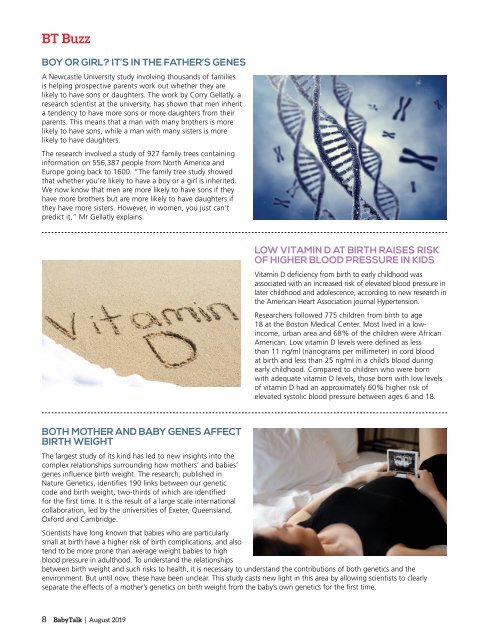BT August 2019
You also want an ePaper? Increase the reach of your titles
YUMPU automatically turns print PDFs into web optimized ePapers that Google loves.
<strong>BT</strong> Buzz<br />
Boy or girl? It’s in the father’s genes<br />
A Newcastle University study involving thousands of families<br />
is helping prospective parents work out whether they are<br />
likely to have sons or daughters. The work by Corry Gellatly, a<br />
research scientist at the university, has shown that men inherit<br />
a tendency to have more sons or more daughters from their<br />
parents. This means that a man with many brothers is more<br />
likely to have sons, while a man with many sisters is more<br />
likely to have daughters.<br />
The research involved a study of 927 family trees containing<br />
information on 556,387 people from North America and<br />
Europe going back to 1600. “The family tree study showed<br />
that whether you’re likely to have a boy or a girl is inherited.<br />
We now know that men are more likely to have sons if they<br />
have more brothers but are more likely to have daughters if<br />
they have more sisters. However, in women, you just can’t<br />
predict it,” Mr Gellatly explains.<br />
Low vitamin D at birth raises risk<br />
of higher blood pressure in kids<br />
Vitamin D deficiency from birth to early childhood was<br />
associated with an increased risk of elevated blood pressure in<br />
later childhood and adolescence, according to new research in<br />
the American Heart Association journal Hypertension.<br />
Researchers followed 775 children from birth to age<br />
18 at the Boston Medical Center. Most lived in a lowincome,<br />
urban area and 68% of the children were African<br />
American. Low vitamin D levels were defined as less<br />
than 11 ng/ml (nanograms per millimeter) in cord blood<br />
at birth and less than 25 ng/ml in a child’s blood during<br />
early childhood. Compared to children who were born<br />
with adequate vitamin D levels, those born with low levels<br />
of vitamin D had an approximately 60% higher risk of<br />
elevated systolic blood pressure between ages 6 and 18.<br />
Both mother and baby genes affect<br />
birth weight<br />
The largest study of its kind has led to new insights into the<br />
complex relationships surrounding how mothers’ and babies’<br />
genes influence birth weight. The research, published in<br />
Nature Genetics, identifies 190 links between our genetic<br />
code and birth weight, two-thirds of which are identified<br />
for the first time. It is the result of a large scale international<br />
collaboration, led by the universities of Exeter, Queensland,<br />
Oxford and Cambridge.<br />
Scientists have long known that babies who are particularly<br />
small at birth have a higher risk of birth complications, and also<br />
tend to be more prone than average weight babies to high<br />
blood pressure in adulthood. To understand the relationships<br />
between birth weight and such risks to health, it is necessary to understand the contributions of both genetics and the<br />
environment. But until now, these have been unclear. This study casts new light in this area by allowing scientists to clearly<br />
separate the effects of a mother’s genetics on birth weight from the baby’s own genetics for the first time.<br />
8 BabyTalk | <strong>August</strong> <strong>2019</strong>

















